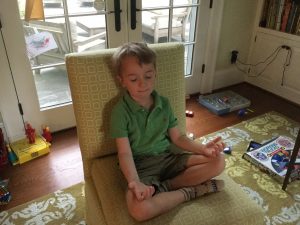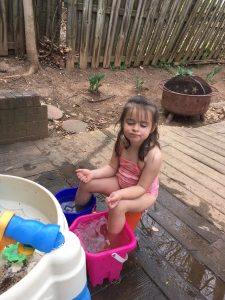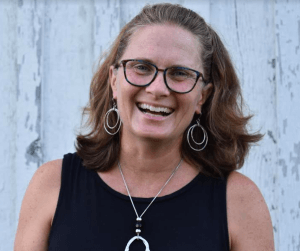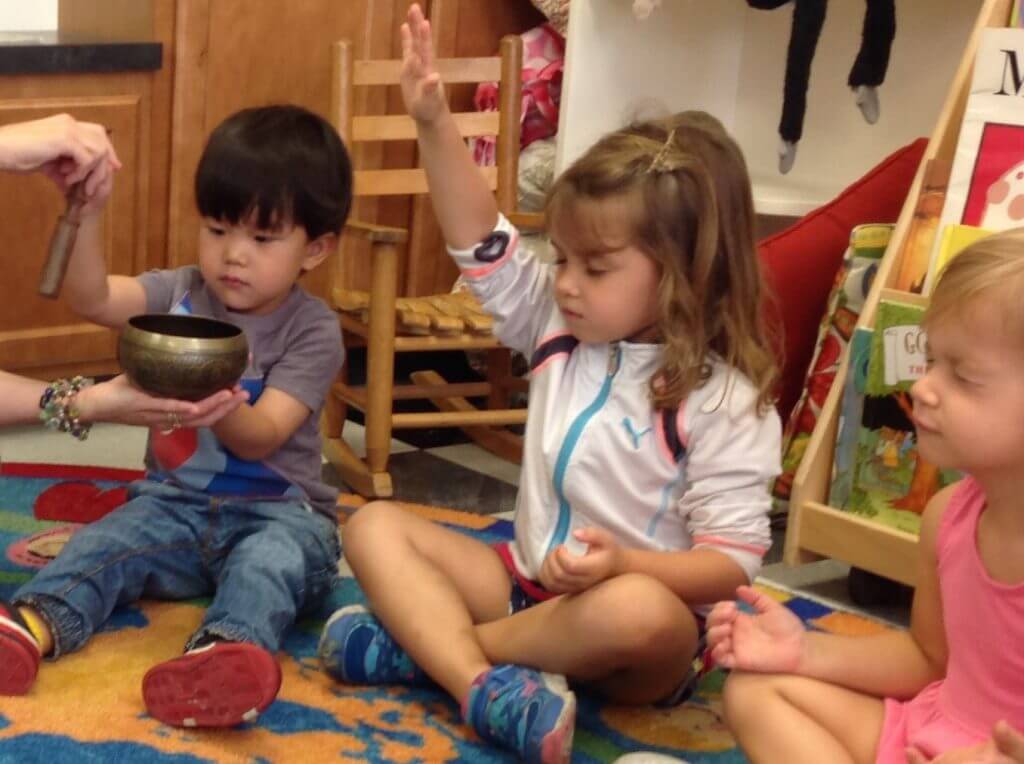“Please get your bodies ready,” the eager four-year old directs her peers, one hand resting on her teacher’s hand with the other poised to ring the bell. After a short interlude filled with rustling sounds, 19 preschoolers are settled on the rug with their legs crossed, hands resting on their laps, and eyes squeezed tight. Their ears are tuned to the sound of the instrument their friend has rung three times. As the sound dissipates, they each raise a hand to signal the close of their mindful listening practice.
“Mindfulness is paying attention in a particular way: on purpose, in the present moment, and non-judgmentally… Exposure to mindfulness training by a skilled teacher can nurture emotional balance…foster greater stress resilience and greater social intelligence and cooperativity – just what one would hope for from an enlightened and engaged citizenry.” – Jon Kabat-Zinn in Mindfulness for Beginners: Reclaiming the Present Moment—and Your Life
A Tool for All Ages

In my teaching career I have led some of our tiniest learners, active adolescents, anxious college students, and intrigued educators in mindfulness lessons. Mindfulness techniques introduced in educational settings offer our students techniques for dealing with whatever comes their way. I’ve seen a three-and-a-half-year-old “find a quiet space to just have some breathing time” in the midst of a rowdy after school playdate. It is inspiring to watch as some of the youngest learners begin accessing their own power to attend, display self-control, and exercise compassion towards others.
Mindfulness has given young teens tools to tackle stressful homework assignments without melting down and college students techniques for handling a panic attack. It is uplifting to witness young, anxious, over-stimulated teens begin to share openly about their daily struggles with academic responsibilities, social confidence, and self-reflection. Whether it is anxiety around academic life, social issues, or habits we find ourselves falling into, mindfulness instruction can offer all of us tools for life.
Mindfulness has a Profound Impact on Students

In education, we place great value on the ability to pay attention, but it is rare that we ever teach how to pay attention. As we can strengthen and build muscle groups to excel in athletic endeavors, we can also train our minds and bodies to excel in any activity that requires focus.
Throughout the years, my students have shared stories of resilience and compassion. It is heart lifting to hear stories of how mindfulness techniques are being incorporated into their daily lives.
“When my brother broke my necklace, I was mad but then I hugged him and breathed.”
“I notice my heart was racing so fast, and I able to use anchor-breathing – focused awareness on one’s core, chest and lungs or nose and mouth – to help me settle my thoughts before presenting my project idea to a panel of professors.”
Recently, more and more research is demonstrating the profound impact that mindfulness can have on children and adolescents. Students who are routinely exposed to awareness building strategies by a trained instructor are better able to attend in class, better able to remember and re-explain information, and participate more fully. The side-effect for both teachers and students is an overall sense of happiness and well-being. Teachers report feeling more connected with their colleagues, and children claim they are happier and that people seem kinder.
Mindfulness Practices to try with Different Ages
Elementary Aged Students
Still Chillin’ is a favorite classroom activity; it’s an adaptation of the Mindful Schools curriculum that I am grateful to have practiced during my year-long training. Here are instructions for trying it out in your classroom:
- Gather students in a circle.
- Ask them to begin moving randomly (careful of your neighbor) while you sing or play a song.
- Then stop the music and say together as a group: “Still…Chillin’!” Everybody FREEZE.
- Teacher serves as “judge,” checking out the “still chillers” who remain frozen in whatever position they chose.
- Students who move and are not able to maintain their poses are invited to join the teacher on the edges of the circle to become judges, watching for stillness.
- Repeat song and “still…chillin’!” until only a few students remain.
- Clap and cheer for all participants and high-five the “chillest-stillest.”
- Start fresh and play again.
This game is often filled with laughter and is a wonderful way to practice being silly, active, calm and in-control in rapid succession.
Extra: Consider teaching kid-yoga moves (“turtle pose, “ “tree pose,” and “mountain”) and having children freeze in those positions, as they choose.
High School Students
Anchor Breathing is a favorite settling technique I use with teens. Use the following script for a guided visualization practice (feel free to modify it!):
Find a comfortable position with your feet flat on the floor. Gently close your eyes, if that feels comfortable. Otherwise, simply rest your gaze on a spot in front of you.

We all have anchor spots on our physical being as well. Here are three anchor spots to practice:
1st: at your belly, your core – placing your hands there, breathing in and allowing your stomach to expand, breathing out and allowing it to contract. Expanding and contracting 3 times. (pause to allow for breathing)
2nd: at your chest and lungs – noticing the rise and fall of your rib cage as you inhale and exhale 3 times. (pause to allow for breathing)
3rd: nose and mouth – cupping your hands together and placing them 2 to 3 inches from your nose and mouth, following the flow of air, temperature change there for 3 breaths. (pause to allow for breathing)
Check in with yourself. Notice how you feel in your thoughts, in your muscles. As you are ready slowly blink open your eyes if they are still closed.
After you finish this practice, allow time for group reflections on how it went.
Mindfulness training offers tools for empowerment, resiliency, and concentration, allowing our students to reach their potentials as academic learners, active listeners, and engaged members of society. While exploring our work with others within our own families, workplaces, or classrooms, I strongly believe in creating a climate of compassion, resiliency and growth. To do this, it is critical to listen deeply to others and reflect on what is being said (both verbal and nonverbally). Valuing the importance of not taking ourselves too seriously, I encourage humor as well. As we prepare all our students to thrive in the future, we’re outfitting the next generation with tools for life by nurturing and challenging their bodies, minds, and spirits.


